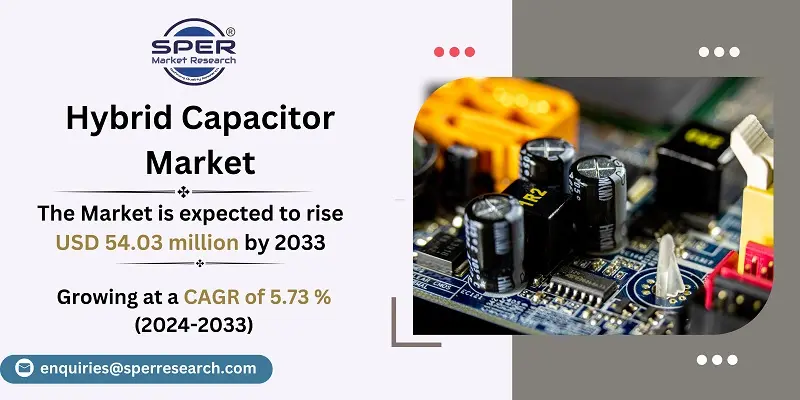
Hybrid Capacitor Market Growth, Size, Trends, Demand, Share, Revenue and Future Outlook
Hybrid Capacitor Market Size- By Product Type, By Application- Regional Outlook, Competitive Strategies and Segment Forecast to 2033
| Published: Apr-2024 | Report ID: SEMI2416 | Pages: 1 - 228 | Formats*: |
| Category : Semiconductor and Electronics | |||
- In May 2021: VINATech Co., Ltd. introduced a new line of 3.8V lithium-ion capacitors. These capacitors offer a high operating voltage, low self-discharge, high capacitance, and an extended operating temperature range.
- Blue Marlin: an energy storage device with high-density lithium-ion capacitors, was acquired by Kawasaki Heavy Industries, Ltd. from Corvus Energy in June 2020. The Blue Marlin is perfect for high power load handling applications because it incorporates LIC technology, which has exceptionally high charge and discharge rates of 220 C continuous and 550 C peak.
- In July 2023: Asahi Kasei begins licensing design and manufacturing technology for lithium-ion capacitors, a sophisticated energy storage device.


| Report Metric | Details |
| Market size available for years | 2020-2033 |
| Base year considered | 2023 |
| Forecast period | 2024-2033 |
| Segments covered | By Product Type, By Application |
| Regions covered | North America, Asia-Pacific, Latin America, Middle East & Africa and Europe |
| Companies Covered | SOCOMEC GROUP, JTEKT Corporation, SPEL TECHNOLOGIES PRIVATE LTD, TAIYO YUDEN CO, LTD, Vishay Intertechnology, Inc, EVE Energy Co, Ltd, LICAP Technologies, Inc, Yunasko, KEMET Corporation, Electro Standards Laboratories. |
- Aerospace Industry
- Automotive Industry
- Distributors
- Energy Storage Solutions Providers
- Investors
- Manufacturers
- Regulatory Bodies
- Research Organizations
| By Product Type: |
|
| By Application: |
|
| By Region: |
|
- Global Hybrid Capacitor Market Size (FY’2024-FY’2033)
- Overview of Global Hybrid Capacitor Market
- Segmentation of Global Hybrid Capacitor Market By Product Type (Laminating Type, Radial Type)
- Segmentation of Global Hybrid Capacitor Market By Application (Power Generation, Transmission, Distribution, Others)
- Statistical Snap of Global Hybrid Capacitor Market
- Expansion Analysis of Global Hybrid Capacitor Market
- Problems and Obstacles in Global Hybrid Capacitor Market
- Competitive Landscape in the Global Hybrid Capacitor Market
- Impact of COVID-19 and Demonetization on Global Hybrid Capacitor Market
- Details on Current Investment in Global Hybrid Capacitor Market
- Competitive Analysis of Global Hybrid Capacitor Market
- Prominent Players in the Global Hybrid Capacitor Market
- SWOT Analysis of Global Hybrid Capacitor Market
- Global Hybrid Capacitor Market Future Outlook and Projections (FY’2024-FY’2033)
- Recommendations from Analyst
1.1. Scope of the report1.2. Market segment analysis
2.1. Research data source2.1.1. Secondary Data2.1.2. Primary Data2.1.3. SPER’s internal database2.1.4. Premium insight from KOL’s2.2. Market size estimation2.2.1. Top-down and Bottom-up approach2.3. Data triangulation
4.1. Driver, Restraint, Opportunity and Challenges analysis4.1.1. Drivers4.1.2. Restraints4.1.3. Opportunities4.1.4. Challenges4.2. COVID-19 Impacts of the Global Hybrid Capacitor Market.
5.1. SWOT Analysis5.1.1. Strengths5.1.2. Weaknesses5.1.3. Opportunities5.1.4. Threats5.2. PESTEL Analysis5.2.1. Political Landscape5.2.2. Economic Landscape5.2.3. Social Landscape5.2.4. Technological Landscape5.2.5. Environmental Landscape5.2.6. Legal Landscape5.3. PORTER’s Five Forces5.3.1. Bargaining power of suppliers5.3.2. Bargaining power of buyers5.3.3. Threat of Substitute5.3.4. Threat of new entrant5.3.5. Competitive rivalry5.4. Heat Map Analysis
6.1. Global Hybrid Capacitor Market Manufacturing Base Distribution, Sales Area, Product Type6.2. Mergers & Acquisitions, Partnerships, Product Launch, and Collaboration in Global Hybrid Capacitor Market
7.1. Global Hybrid Capacitor Market Size, Share and Forecast, By Product Type, 2020-20267.2. Global Hybrid Capacitor Market Size, Share and Forecast, By Product Type, 2027-20337.3. Laminating Type7.4. Radial Type
8.1. Global Hybrid Capacitor Market Size, Share and Forecast, By Application, 2020-20268.2. Global Hybrid Capacitor Market Size, Share and Forecast, By Application, 2027-20338.3. Power Generation8.4. Transmission8.5. Distribution8.6. Others
9.1. Global Hybrid Capacitor Market Size and Market Share
10.1. Global Hybrid Capacitor Market Size and Market Share By Region (2020-2026)10.2. Global Hybrid Capacitor Market Size and Market Share By Region (2027-2033)10.3. Asia-Pacific10.3.1. Australia10.3.2. China10.3.3. India10.3.4. Japan10.3.5. South Korea10.3.6. Rest of Asia-Pacific10.4. Europe10.4.1. France10.4.2. Germany10.4.3. Italy10.4.4. Spain10.4.5. United Kingdom10.4.6. Rest of Europe10.5. Middle East and Africa10.5.1. Kingdom of Saudi Arabia10.5.2. United Arab Emirates10.5.3. Qatar10.5.4. South Africa10.5.5. Egypt10.5.6. Morocco10.5.7. Nigeria10.5.8. Rest of Middle-East and Africa10.6. North America10.6.1. Canada10.6.2. Mexico10.6.3. United States10.7. Latin America10.7.1. Argentina10.7.2. Brazil10.7.3. Rest of Latin America
11.1. SOCOMEC GROUP11.1.1. Company details11.1.2. Financial outlook11.1.3. Product summary11.1.4. Recent developments11.2. JTEKT Corporation11.2.1. Company details11.2.2. Financial outlook11.2.3. Product summary11.2.4. Recent developments11.3. SPEL TECHNOLOGIES PRIVATE LTD.11.3.1. Company details11.3.2. Financial outlook11.3.3. Product summary11.3.4. Recent developments11.4. TAIYO YUDEN CO., LTD.11.4.1. Company details11.4.2. Financial outlook11.4.3. Product summary11.4.4. Recent developments11.5. Vishay Intertechnology, Inc.11.5.1. Company details11.5.2. Financial outlook11.5.3. Product summary11.5.4. Recent developments11.6. EVE Energy Co., Ltd.11.6.1. Company details11.6.2. Financial outlook11.6.3. Product summary11.6.4. Recent developments11.7. LICAP Technologies, Inc.11.7.1. Company details11.7.2. Financial outlook11.7.3. Product summary11.7.4. Recent developments11.8. Yunasko11.8.1. Company details11.8.2. Financial outlook11.8.3. Product summary11.8.4. Recent developments11.9. KEMET Corporation11.9.1. Company details11.9.2. Financial outlook11.9.3. Product summary11.9.4. Recent developments11.10. Electro Standards Laboratories11.10.1. Company details11.10.2. Financial outlook11.10.3. Product summary11.10.4. Recent developments11.11. Others
SPER Market Research’s methodology uses great emphasis on primary research to ensure that the market intelligence insights are up to date, reliable and accurate. Primary interviews are done with players involved in each phase of a supply chain to analyze the market forecasting. The secondary research method is used to help you fully understand how the future markets and the spending patterns look likes.
The report is based on in-depth qualitative and quantitative analysis of the Product Market. The quantitative analysis involves the application of various projection and sampling techniques. The qualitative analysis involves primary interviews, surveys, and vendor briefings. The data gathered as a result of these processes are validated through experts opinion. Our research methodology entails an ideal mixture of primary and secondary initiatives.



Frequently Asked Questions About This Report
PLACE AN ORDER
Year End Discount
Sample Report
Pre-Purchase Inquiry
NEED CUSTOMIZATION?
Request CustomizationCALL OR EMAIL US
100% Secure Payment






Related Reports
Our Global Clients
Our data-driven insights have influenced the strategy of 200+ reputed companies across the globe.




















